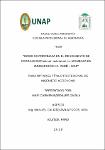Dosis de porcinaza en el rendimiento de forraje en Panicum máximum cv. mombaza en Zungarococha, Perú - 2019
Abstract
The research work was carried out at the National University of the Peruvian Amazon, entitled PORCINAZA DOSE IN FORAGE PERFORMANCE IN Panicum Máximum cv. MOMBAZA IN ZUNGAROCOCHA, PERU - 2019. The evaluations were made 60 days after sowing with vegetative seed (stakes), in plots of 3 m x 1.2 m (3.6 m2) and an experimental area of 170 m2. With a Randomized Complete Block Design (DBCA), with five treatments and four repetitions, the treatments under study were: T0 (0 tons of pigs / ha), T1 (10 tons of pigs / ha), T2 (20 tons of porcinaza / ha), T3 (30 tons of porcinaza / ha) and T4 (40 tons of porcinaza / ha), obtaining the following results: With the
dose of 20 tons of Porcinaza / ha (T4) it was possible to increase the height of plant, green matter, dry matter, and the yields of green matter per plot and per hectare (Kg). In this sense, it was shown that the doses of Porcinaza favorably influenced the agronomic characteristics of Panicum maximum cv. MOMBAZA, in the same way the percentage (%) of coverage was also favored with the highest dose of Porcinaza (20 tons / ha). According to what was found in this work, the application of Porcinaza doses is presented as an alternative to improve agronomic characteristics and increase forage yield for the supplementation of the dietary diet of monogastric and ruminant animals. It is considered that this forage species is easily adapted to agricultural systems because of its easy propagation and management in the crop. El trabajo de investigación se realizó en la Universidad Nacional de la Amazonia Peruana, titulado DOSIS DE PORCINAZA EN EL RENDIMIENTO DE FORRAJE EN Panicum máximum cv. MOMBAZA EN ZUNGAROCOCHA, PERU - 2019. Las evaluaciones fueron realizadas a los 60 dias después de la siembra con semilla vegetativa (estacas), en parcelas de 3 m x 1.2 m (3.6 m2) y un área experimental de 170 m2. Con un Diseño de Bloques Completo al Azar (D.B.C.A), con cinco tratamientos y cuatro repeticiones, los tratamientos
en estudio fueron: T0 (0 toneladas de porcinaza/ha), T1 (10 toneladas de porcinaza/ha), T2 (20 toneladas de porcinaza/ha), T3 (30 toneladas de porcinaza/ha) y T4 (40 toneladas de porcinaza/ha), obteniendo los siguientes resultados: Con la dosis de 20 toneladas de Porcinaza/ha (T4) se logró se logró incrementar la altura de planta, materia verde, materia seca, y los rendimientos de materia verde por parcela y por hectárea (Kg). En este sentido, se demostró que las dosis de Porcinaza influyeron favorablemente en
las características agronómicas de forraje Panicum máximum cv. MOMBAZA, de igual manera el porcentaje (%) de cobertura también se vio favorecido con la mayor dosis de Porcinaza (20 toneladas/ha). de acuerdo con lo encontrado en este trabajo, la aplicación de dosis de Porcinaza se presenta como una alternativa para mejorar las características agronómicas e incrementar el rendimiento de forraje para la suplementación de la dieta alimenticia de animales monogástricos y rumiantes. Se debe considera que esta especie forrajera es de fácil adaptación a los sistemas agropecuarios por su fácil propagación y manejo en el cultivo.
Collections
- Tesis [675]


